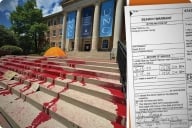You have /5 articles left.
Sign up for a free account or log in.
ANAHEIM, CALIFORNIA -- Faculty development is like a computer. Unless maintenance is performed at a regular basis with relevant updates, both risk becoming outdated to the point where students are unable to benefit.
That was the analogy used by two technology officials from St. Mary’s University of Texas as they presented their university’s approach to faculty development here on the first full day of seminars during the annual Educause conference.
Speaking to a crowd of about 25 university IT officials, Jeff Schomburg, director of the St. Mary’s Center for Instructional Technology, and Michael Chen, executive director of the center’s academic technology services division, said IT officers need to convince their administrations that, like replacing old computer hardware, investments in faculty development can’t be a one-time expense.
“You need to really implement a life cycle,” Chen said. “Technology is not just a tool [for faculty] to do their old jobs better. There are new tasks, and they have to realize that. You have to keep changing with the times.”
St. Mary’s, which enrolls about 4,000 students, began offering faculty development programs to faculty members in 2000 with the aid of a federal Title V grant, awarded to institutions that serve large Hispanic populations. The funding enabled faculty members to cut three hours from their teaching load to attend the weekly program for one semester. When the funding dried up in 2005 and the university shifted resources elsewhere, Chen and Schomburg pitched the idea to institutionalize faculty development by offering a yearlong program to instructors who expressed an interest in learning to use technology in their courses.
“It’s never just a ‘Well, I taught you once, I bought a projector once,'” Schomburg said. “It’s got to be ongoing.”
Faculty members at St. Mary’s apply to the program in February, and the most promising applications are selected by their deans in March. At the end of the spring semester, the faculty members attend a four-day institute on learning technologies. The new academic year starts with a two-day technology conference, and the fall and spring semesters are marked by faculty members showcasing their experiences with using technology in their courses.
Schomburg said the university has this year budgeted about $12,000 for the faculty development program. Most of that funding -- about $10,000 -- goes toward the summer institute, which includes keynote speaker fees and faculty incentives, this year in the form of iPads for the 12 instructors in attendance. The program has so far helped faculty members flip their classrooms, but also reach smaller goals, like being able to lead students through a video assignment.
When asked to identify the challenges stopping them from creating similar faculty development programs, participants, who represented institutions as different as Mesa Community College and Aalborg University in Denmark, voiced many of the same issues -- among them the ever-present funding issues and lack of administrative support. These views were in many ways consistent with the findings in Inside Higher Ed's survey on faculty attitudes on technology, released in August.
Amy Ostrom, an instructional technologist at the College of Charleston, said faculty members at her institution are awarded a stipend to participate in faculty development classes, but that the programs represent an additional commitment on top of teaching and researching. She joined other participants in saying institutions need to follow up with faculty members to ensure the skills they gained don’t go to waste.
Representatives from larger universities and state systems said individual schools and departments are hosting faculty development sessions on their own, but that the institution as a whole may lack an overarching strategy.
“We have dozens of these people sprinkled across the university not necessarily working together,” said Julian Allen, director of professional and technical support services at Georgia State University.
One popular idea that emerged from the session was to centralize faculty support and technology services, creating a one-stop shop. Such a center could provide support for faculty members looking to take their courses online, but also a safe haven for those needing remedial help. That could make faculty development more appealing to those who don’t participate for fear of “sitting a group with their colleagues, their peers and not know something,” as Elise Fisher, director of instructional technology at William Jewell College, put it.
“Faculty don’t want to be told they’re students,” Schomburg said to murmurs of agreement from the audience.
Later, Ostrom added, “They also don’t like to trained ... by students.” Schomburg pushed back on that statement, and said St. Mary’s faculty institute now features student roundtables. If A-students are ignoring the technology used in the classroom, he said, “just think what the Bs, Cs and Ds are doing.”
To gauge what the audience hoped to gain from the session, Schomburg polled the participants in the room and converted the results into a word cloud (pictured above). The words “faculty,” “engaging,” “learning” and “technology” loomed large.
Those words in some sense reflected how St. Mary’s has changed the focus of its faculty institute. In 2010, Schomburg said more sessions featured vendor presentations on specific technology, like demonstrating Skype calls and podcasting through iTunes U. This year’s institute, however, talked more about pedagogy and instructional design.
Schomburg said, “It’s less about ‘Here’s how I use this exact tool’ and more about the bigger picture.”








